How to Remove Hard Water Buildup From Faucets and Showerheads
This post may contain affiliate links. Read my full disclosure here.
In many parts of the country, having to remove hard water buildup is a necessity. Our well water is hard (it has a lot of calcium and magnesium in it), plus it has rust and particulates. Even with a softener and whole house particulate filter, over time deposits build up in the faucets and shower heads. I noticed recently that the kitchen and bathroom faucets and the shower head had reduced flow, plus a lot of the water was spraying the wrong direction. It was time for a good cleaning.
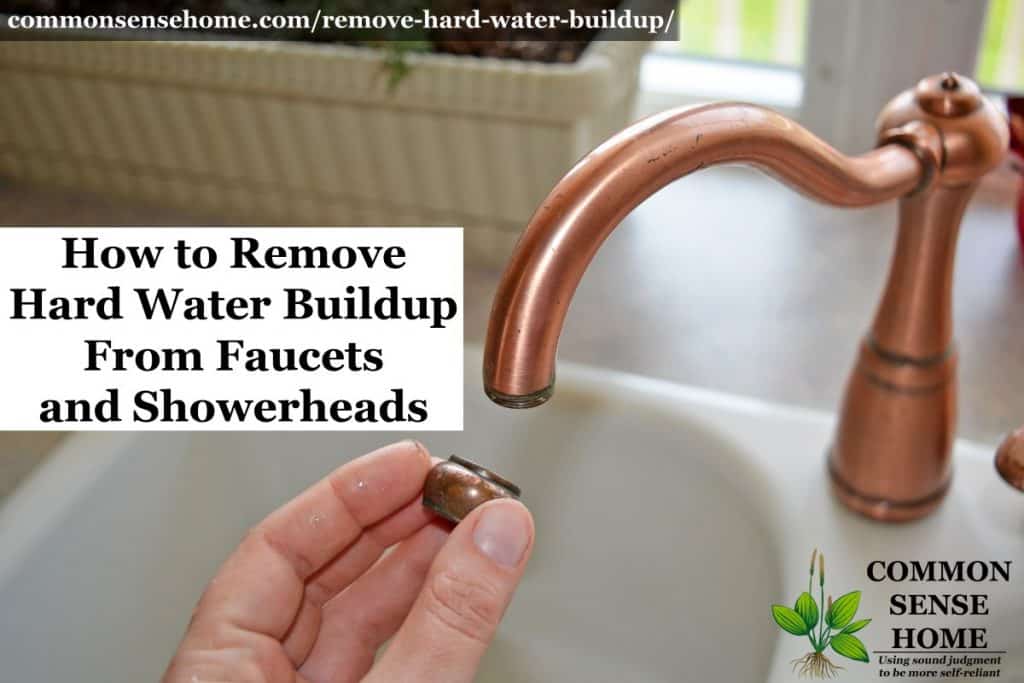
How to Remove Hard Water Buildup on Your Faucets and Showerheads
Note: This treatment is not suitable for iron or nickel fixtures, which may break down if soaked in vinegar. If you’re not sure if your fixtures are iron or nickel, test some diluted vinegar (1 part vinegar:4 parts water) on a very small area (apply with a cotton swab) and see if the metal rubs off along with the hard water buildup.
To remove hard water deposits from your faucet, start by unscrewing the end of the faucet (see above). This is our kitchen sink faucet, but all faucets should have a small, removable filter at the end.
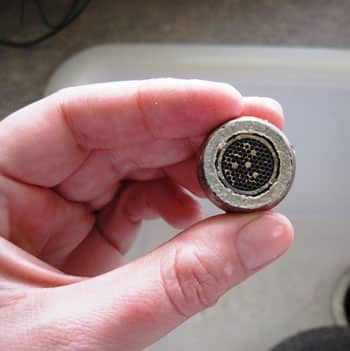
As you can see, there’s a lot of buildup on this one. Remove any rubber gaskets (don’t lose the pieces and pay attention to what order they assemble in the unit). Manually give the filter a good scrub with an old toothbrush under running water. This will remove loose surface deposits.

Here’s the secret for removing the calcium and rust in a hurry. Because calcium is an alkaline earth metal (meaning it has two valence electrons in its outer shell), it’s highly reactive with acids, like vinegar. If we apply a little more kitchen chemistry, you’ll remember that chemical reactions require energy, so heat up enough vinegar (I usually use white vinegar for cleaning) to fully submerge the faucet filter. Get it hot enough so that it’s uncomfortable to stick your finger in it, but not boiling. Place the faucet filter in the hot vinegar, and watch it go to work. See all those little bubbles?
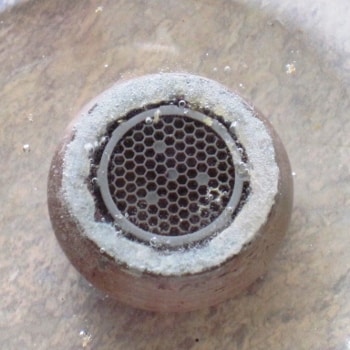
Let it sit until it stops bubbling (I left mine in for an hour or so while I went and worked on other things). Give it a good rinse and scrub with the toothbrush, and it looks almost like new.
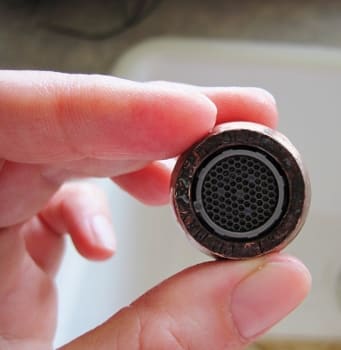
Would you like to save this?
The water flows the way it’s supposed to again, too.
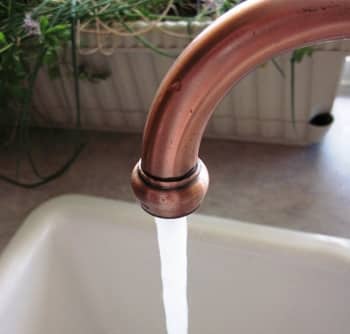
Note: We don’t just have a copper faucet because it looks pretty. Copper also naturally anti-bacterial, so it fights germs and may reduce illness.
If you have a chrome faucet that’s in really bad shape, you can also get replacement aerators and just swap out the end of the faucet.
The showerhead was in much the same state.
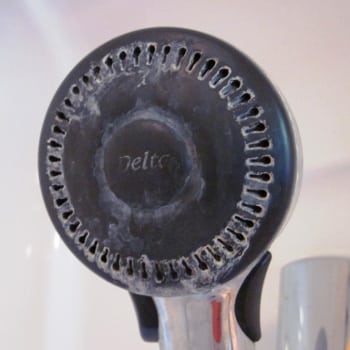
Because we have hand-held showerheads, I just placed the shower head in a basin on the shower floor.
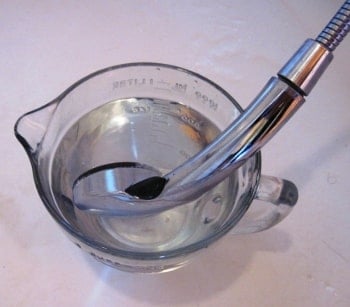
If you don’t have a hand-held showerhead, you can use a plastic bag and a rubber band to secure the vinegar around the showerhead for soaking.
Scrub and rinse, and ta-da! Much better! Now the shower doesn’t spray sideways past the shower curtain any more. 🙂
Recommended posts:
- Natural Stove Cleaners
- How to Get Rid of Mice in Your Home and Garage
- Natural Mosquito Repellents That Work
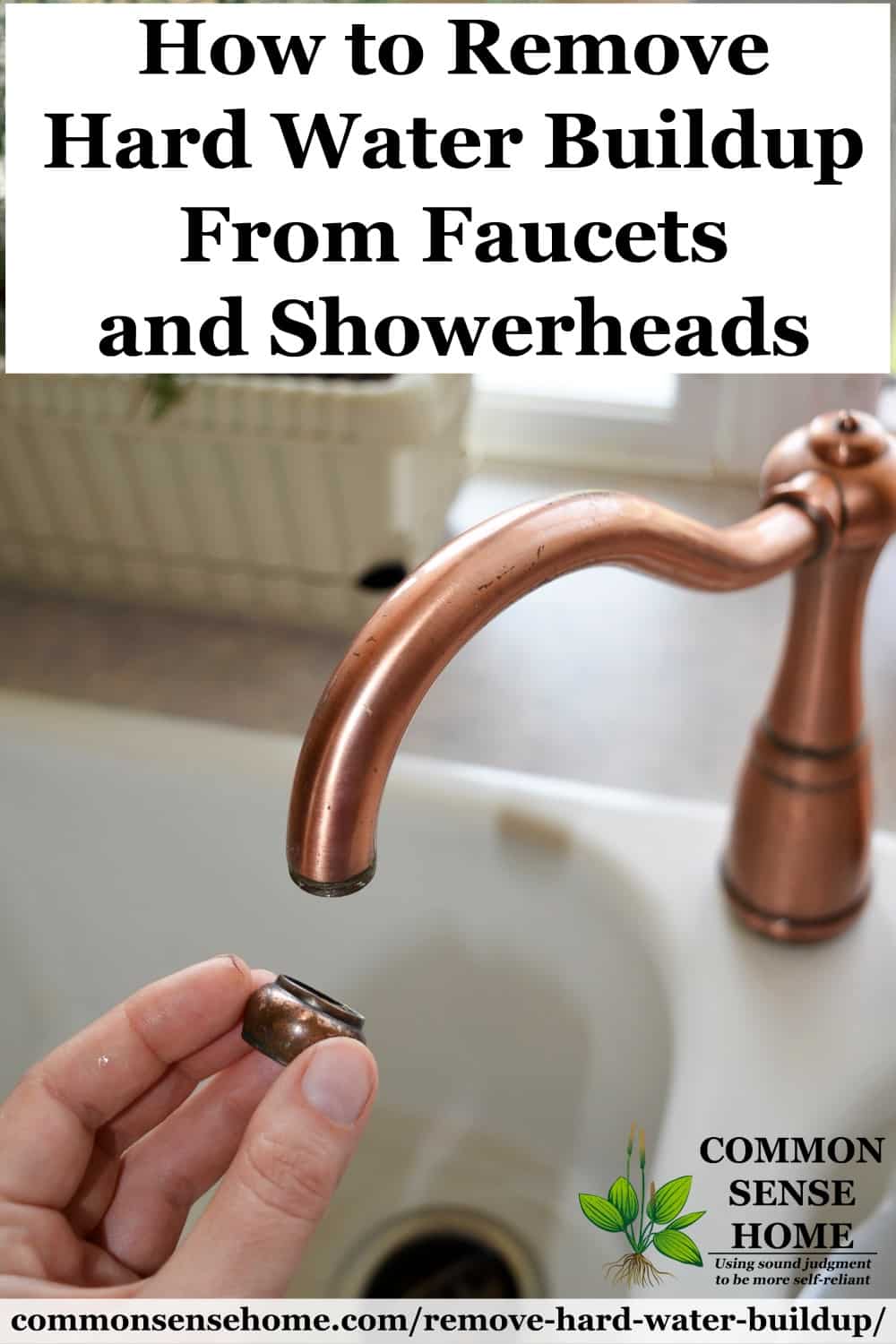
Originally published in 2011, updated in 2016.

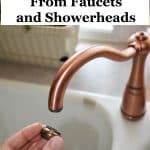
I am so excited to try this. We also live in the midwest and I’ve wanted to tackle this cleaning problem but wasn’t sure how. Thank you.
So vinegar should be safe to use on bronze and matte black faucets? I’ll test a small area first but I’m finding mixed reviews about using vinegar on bronze. Thanks!
I suspect you’re finding mixed reviews because the quality of bronze faucets varies. I think the matte black coating is electroplated on, so it should be stable, but please test both on a small area before doing a larger area soak.
Came here looking for confirmation that using vinegar was the right approach to remove buildup from a cheapish garden sprayer that’s been attached to the same hose for a few years (had to use vice grips to remove it, it was stuck so tight!). I forgot about heating the vinegar up, and will try that in a bit.
I’m just reminded of a few years ago when I got tired of my shower head spraying every which way but straight, I was delighted to discover that the holes on it are little rubber cones, and all I have to do to remove the deposits is temporarily deform the rubber with my thumb, and the deposits come right off!
When too much water is going the wrong direction, you know it’s time for the soak. 😉
I have shower doors. What can I use to clean the shower track? No problem cleaning the doors. Thanks
Drape a vinegar and water soaked cloth over the tracks and let it sit to penetrate. Scrub with a rough green scrubbie pad.
Does this calcification get into our bodies? If it does, how do we get it out?
Into your body? Not really an issue given that we have a stomach filled with acid much stronger than vinegar. Hard water can leave a film on the skin and make soap more difficult to rinse off. You can so some extra buffing with your towel or try dry brushing if you feel this is an issue for you.
Thank you. Can’t wait to try on myself friends shower faucet lever. It has been stuck as long as I can remember. Will post results of it works.
Remember to test on a small area first and make sure it doesn’t eat the faucet lever. I just unclogged my kitchen sink sprayer tonight. The boys are excited, since they use it more than I do.
I managed to remove the entire shower head. Most looks like metal, but the face where the water comes out, all the little holes seems to be plastic. Water was barely coming out at all. Did not notice this as it was in a bathroom that hasn’t been used in awhile.
All I have is apple cider vinegar. Would that work???
It should work the same as white vinegar. I just use white vinegar for cleaning since it’s cheaper.
If you don’t want cheap, stop buying at the box stores. They’re cheap. Buy from a plumbing retailer like Ferguson. They sell what the pro’s buy not the cheap version that box stores sell. Don’t think there is a difference? You’re wrong. Ask a plumber.
Box store faucet = plastic supply lines, plastic parts, plastic, plastic
Pro faucet = metal mesh supply lines, ceramic disc cartridge, metal pop up, metal, metal
People think the $60 difference in a pro faucet vs. box store is just added markup. It’s not. The box store tells Delta, Kohler or whoever that they want to sell a faucet for $90, the manufacturer finds ways to cheapen it to get to that price point. The saddest part is the manufacturer will call the faucet by the same name as the pro faucet making the consumer think it’s the same item. It only appears to be the same item!
The same is true for small equipment like mowers and chainsaws, too. Companies generally have two grades of product, and I’d rather invest in something that I’m not going to need to replace in short order.
Another thing to consider is those lifetime warranties. I have pro Delta faucets, and instead of having to replace various parts over time, I just call Delta and within a few days the part is in my mailbox! I’ll never do big box plumbing fixtures again. Plus, their service reps help you figure out what’s wrong and how to fix it.
Thank you for this article, too!
Does that actually work? We had Delta pro faucets, too, but the warranties listed on the website specifically noted that the replacement policy did not include normal wear and tear.
I have to replace the filter for the ice maker in my refrigerator and I can not get it out. It is on the top of the inside. I know it is calcified (has been in 3 years) Any suggestions? No way to use plastic bag.
You may be out of luck, but it wouldn’t hurt to try placing a big, steaming hot container of vinegar in the area and closing it in, to see if the vinegar fumes can work into the area. Note – this may get vinegar into other areas that you don’t want vinegar in, so there is a risk of damage to your fridge. I assume no liability if you try it. Ice makers are a common fail point in fridges – which is why we didn’t get one in ours. Alternatively, you may try contacting the manufacturer or a local repair shop to see if they have any tricks or tips for your particular model.
It was a severe pain in the ass, but I was able to fix the little knob that pulls up to start the shower. It had fused closed and I stripped the screw so I can’t remove the tap ever again. I held a bag of hot vinegar over the end of the tap with a bucket underneath since it was impossible for it not to leak out. It only took about 10 minutes and the knob thinger moves again! I loosened it with pliers.
It was very frustrating to figure out but i managed not to smash anything in anger.
Hard water is a PITA. Glad you didn’t smash anything and got it working again.
I have one of those pull out to turn on shower faucets. It pulls so hard I am afraid of breaking something. I assume the cause is calcium build up. Any way to remove the buildup inside the faucet?
Not that I’m aware of, short of some sort of whole plumbing purge, but that might do more harm than good as deposits peel off and get gummed up in even worse places. You may want to check with a local plumber to see if they have any suggestions. It may be just the type of fixture, or there may be some way it can be adjusted.
I am about to execute your tip on getting rid of hard water build up with white vinegar in my bathroom. This question is kind of off topic but thought I would ask – can you recommend a good (not pricy), filtered shower head? I am also looking for a filter to put on the bathroom sink faucet (i.e. filter ball that hangs down under faucet, etc?)? Thanks Much – Aly
The Aquacare HotelSpa filter has a larger 6 setting head, a 3 stage filter and all 4-5 star reviews. The Culligan WSH-C125 has a 5 spray setting head and says that it removes chlorine, but it’s not clear what type of filter setup it has. It has an overall rank of 4.5 stars, with many more reviews. Both are right around $30.
The faucet filters seem to get more mixed results. Most of them are larger, geared for use with a kitchen faucet, such as the Culligan FM-25 for just under $20. The only ball type faucet filter I found was the Bath Ball Faucet Filter, which is more expensive ($55) and would be tricky to attach to some faucets.
Hi, Laurie, I am seeing your reply for the first time, today. I don’t know why I missed any prior notification. Anyway, thanks so much for the shower head & faucet, filter referrals. When I wrote my original post, I was looking for tips on how to remove Calcium and Lime build up in bath faucets. I ended up trying the tip to attach a plastic bag to the bath tub faucet, filled with warmed. White Vinegar. Unfortunately, I didn’t know my faucet was made of brushed nickel. So this resulted in partial, disintegration of the faucet. My fault. But, I am glad it worked out that way because the faucet was old, and inexpensive to just replace. When I twisted off the original (half disintegrated), faucet- regardless of being submerged in, and breaking down from white vinegar, there was nasty, blue/green slime in the faucet. I was happy to have replaced it. Thanking, you, and All comments, from this post, to help problem solve this issue.
Glad that you got the slime cleared out.
Thanks for this post. Last night my sink had very light pressure. I went online and read about 6 or 7 articles, but they all assumed I would be able to screw the bottom off of the faucet but my faucet is just one piece. In order to access the screen at the end I would have had to disassemble the entire faucet and remove it from the base and I wasn’t about to attempt that. I was just about to call a handyman when I saw your tip about the vinegar. I heated up vinegar, put it in a plastic bag and placed it over my faucet with a rubber band and it worked! Now my faucet works fine. That tip saved me a big headache and a lot of money.
So glad the post helped you out!
My bathroom faucet does not have a piece that screws off. It has a built in screen, and it is full of deposits. What is the recommendation to clean it? Maybe a ziplock bag with vinegar rubber banded to the faucet?
It’s worth a try, as long as the faucet itself isn’t reactive.
I have used twist ties to attach a sandwich bag full of white vinegar to the faucet, works great. Our pipes are galvanized (awful) have to get the rust out of the shower head by just taking it off and soaking the head to get hard water out. Canton Ohio water is awful.
Thank you so much for the tips, it worked amazingly !!
Glad that it worked well for you.
Just beware of cheap shower heads. I used vinegar on one to clean the deposits off it. I found out that the inside parts were made of some kind of pot metal that the vinegar disintegrated… the whole thing fell apart. 🙁 I was glad I was able to at least get my money back for it.
Oh nuts! I’ve treated mine several times over the years (it’s almost ten years old now), and so far no problems. It’s so frustrating how cheaply some stuff is made nowadays.
Thanks for sharing! I’ve always been too lazy to get out the vinegar and go to town on my faucets. But I just spent a ton of effort scrubbing away lime from the kitchen sink. I think its well worth trying the vinegar on the shower head. Mine is still new enough that it shouldn’t need drastic work, but it’s already starting to have some streams shooting to the side.
Helene
Thanks for the reminder! I’ll do the bathroom shower right now and work on the sinks next!
“Almost spring” cleaning. 😉
Be aware that vinegar can DAMAGE the finish of some faucets, like brushed nickel.
Exactly! I ruined my newish $200 Delta brushed nickle kitchen faucet with vinegar. If only I had seen this first.
Everywhere you look, you see people suggesting vinegar for faucets, but they don’t caution about the risk with nickle. I’ve used it on other faucets and it worked great. Maybe I just won’t buy Delta brand or nickle.
As a community service, you could post a note on the websites you saw that didn’t advise as you have here, about nickel. $200 augh !
Something simple and to the point.
WARNING: Do Not use straight Vinegar on NICKEL !
Vinegar is likely to damage Nickel finishes
Test a diluted mix (1 vinegar : 4 water) on discrete area first
I just googled “cleaning nickel” and found this page http://www.wikihow.com/Clean-Nickel-Plating
It offers a number of options, one being vinegar, but suggests using a diluted form (1 : 4 part ratio).
It does also say vinegar is abrasive on nickel.
You could include the “wikihow” & “common sense home” url’s with your posts.
PS Thanks for creating this site !
Sharing the good news !
I am aware of the use of white vinegar for cleaning off hardened lime deposits.
By any chance, can you recommend anything to prevent the formation of the deposits on outside hose/faucet connections. Is there anything that can be applied to the connection where the hose is screwed onto the outside faucet. Also, I have encountered problems where the nozzle attaches to the hose. I’ve had to throw away hoses that no longer can be used because a busted nozzle cannot be unscrewed.
Off the top of my head, I know you can splice on a new hose end using a kit, so you could salvage a hose if just the end is trashed. I’ll ask my brother for thoughts on the rest of this. He’s the family handyman.
Rich says, “Pipe joint compound acts as a sealer and as an anti-corrosion agent. Should do the job.”
‘commonsense idea is one alternative’.I’ve had the same battle like every one else.You might try coating the threads w/vaseline,this has saved me a lot,from wasting hose ends and sprayers(the ones made w/ aluminum,thee worst!!),give it a try,I think you’ll be surprised.
I’ve noticed in the past few years that brass is disappearing from hose ends and nozzles. Lots of them are now made of aluminum with a brass colored coating. The aluminum WILL corrode and permanently weld the hose end and nozzle together – it’s not calcium, it’s aluminum corrosion. Nowadays when I buy a new hose or nozzle, in the store I scrape the “brass” with a pocket knife to see if the brass color comes off and is white underneath. Unless you are paying top dollar for a true commercial hose, most are now aluminum with brass colored anodizing. I’ve also seen a few hoses and nozzles with a thin brass shell on the outside but aluminum threads inside.
If I HAVE to buy an aluminum fitting, when I install it I add a thick coat of silicon grease or I apply several layers of teflon tape.
I’ve noticed the quality going down, too. Most of the new stuff is garbage – aluminum or even plastic where it shouldn’t be. Thanks for the protection tip.
Thanks, Annette.
Nice post! 🙂